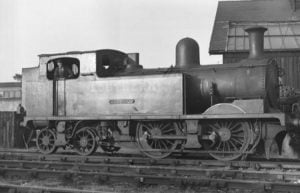This week's Solo Survivor will be looking at the London & South Western Railway's O2 class, which were small 0-4-4s tank engines. Once we have looked at their working life under the ownership of three different railways, we will then look at the preservation history of the only member left.
LSWR O2 Class
In the late 1880s, there was a need for a new class of locomotives to haul ever-increasing commuter traffic around London's growing suburbs and other cities in the South. The class would also replace older tank engines, such as Beattie Well Tank. Therefore the new locomotives would need to be small and powerful engines, capable of fast acceleration. With these criteria, the plans for the O2 class were drawn up and Nine Elms Works started production.
The basic dimensions for the class include: 0-4-4 wheel arrangement (coupled wheels – 4 foot (ft) 6 inch (in) and trailing truck – 3ft 1in), boiler pressed at 160 lbf/in2, two cylinders (two inside) (17 1/2 in diameter and 24 in stroke), total weight came in at 48.4 long tons and a tractive effort of 17,235 lbf.
Productive Series
- 1889 – Order O2, No.177 to 186 (10)
- 1890 – Order B3, No.187 to 196 (10)
- 1891 – Order K3, No.197 to 206 (10)
- 1891 – Order D4, No.206 to 226 (20)
- 1894 – Order R6, No.227 to 236 (10)
All engines constructed at LSWR's Nine Elms Works.
Performance in Service

The class were initially based around London to haul the various commuter trains they were needed on. They proved good engines on these services and were solely allocated to them. Not even a decade after they had been launched into service they began to replaced by bigger tank engines. With this, the class moved to small branch lines where their light axle loading and small coupled wheels diameter were ideal. They continued these duties until the mid-1930s, when electrification and introduction of newer classes of steam locomotives displaced engines allocated on the commuter trains, in turn affecting the O2s. This resulted in displaced O2 tanks, with the Isle of Wight taking many engines of the class. The island's railways for some time had requested to purchase the O2 tanks for operation on the island, leading to 23 being sent to the island between 1923 and 1949, after minor modifications.
Decline and Withdrawal
Through both Southern Railway's and British Railway's ownership, newer engines replaced older ones, which eventually lead to the O2s being made redundant. This started in the Mid-1920s, with these initial engines heading for the Isle of Wight for a new lease of life. Later members of the class were out of gauge for the island's track and subsequently were scrapped when the SR or BR had no further use for them. By 1962 the class based in the Southern Region of BR had been completely broken up, with Isle of Wight engines surviving until Early 1967.
Preservation
The Sole Survivor of the class is No.209, which was one of the locomotives transferred to the Isle of Wight. Operational life on the mainland UK ended in 1924, with the following year moving to the island. Before leaving some minor changes were made so they engine could haul trains on the Isle of Wight. These being the fitting of Westinghouse air brake equipment (to be able to haul the island's air braked stock) and increasing bunker size to carry more coal, extending the engine's range. No.209 also received a new number and name, No.W24 “Calbourne”.
Preservation started in 1967 when the Wight Locomotive Society purchased W24 after electrification on the island made the locomotive surplus to requirement. Calbourne became the Isle of Wight Steam Railway's first engine. Since the railway's start, W24 has seen much action along the line alongside other members of the home fleet. The engine has appeared in a variety of liveries over its 51 years on the line, with the current livery being BR Lined Black with Late Crest. The last overhaul was completed in 2010.
Considering a visit to see W24 “Calbourne” on the Isle of Wight Steam Railway? You can read about my visit here.
We hope you have enjoyed discovering more about W24 “Carbourne” in this week's Sole Survivor. Two weeks time we shall be back again with another Sole Survivor. Both a Lost Class and Class Information will be able to be read in the meantime.
- Visit the RailAdvent news homepage
For the latest railway news - Visit the RailAdvent Shop
For railway related goodies! - Visit LocoStop – Our New Social Network
Come and share your photo's and video's, join the discussion.
Find out what others are sharing